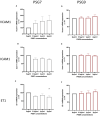PSG7 and 9 (Pregnancy-Specific β-1 Glycoproteins 7 and 9): Novel Biomarkers for Preeclampsia
- PMID: 35322669
- PMCID: PMC9075453
- DOI: 10.1161/JAHA.121.024536
PSG7 and 9 (Pregnancy-Specific β-1 Glycoproteins 7 and 9): Novel Biomarkers for Preeclampsia
Abstract
Background Preeclampsia is pregnancy specific, involving significant maternal endothelial dysfunction. Predictive biomarkers are lacking. We evaluated the biomarker potential, expression, and function of PSG7 (pregnancy-specific β-1 glycoprotein 7) and PSG9 (pregnancy-specific β-1 glycoprotein 9) in preeclampsia. Methods and Results At 36 weeks gestation preceding term preeclampsia diagnosis, PSG7 and PSG9 (in Australian cohorts of n=918 and n=979, respectively) were significantly increased before the onset of term preeclampsia (PSG7, P=0.013; PSG9, P=0.0011). In samples collected at 28 to 32 weeks from those with preexisting cardiovascular disease and at high risk of preeclampsia (Manchester Antenatal Vascular Service, UK cohort, n=235), both PSG7 and PSG9 were also significantly increased preceding preeclampsia onset (PSG7, P<0.0001; PSG9, P=0.0003) relative to controls. These changes were validated in the plasma and placentas of patients with established preeclampsia who delivered at <34 weeks gestation (PSG7, P=0.0008; PSG9, P<0.0001). To examine whether PSG7 and PSG9 are associated with increasing disease severity, we measured them in a cohort from South Africa stratified for this outcome, the PROVE (Preeclampsia Obstetric Adverse Events) cohort (n=72). PSG7 (P=0.0027) and PSG9 (P=0.0028) were elevated among patients who were preeclamptic with severe features (PROVE cohort), but not significantly changed in those without severe features or with eclampsia. In syncytialized first trimester cytotrophoblast stem cells, exposure to TNFα (tumor necrosis factor α) or IL-6 (interleukin 6) significantly increased the expression and secretion of PSG7 and PSG9. In contrast, when we treated primary endothelial cells with recombinant PSG7 and PSG9, we only observed modest changes in Flt-1 (FMS-like tyrosine kinase-1) expression and Plgf (placental growth factor) expression, and no other effects on proangiogenic/antiangiogenic or endothelial dysfunction markers were observed. Conclusions Circulating PSG7 and PSG9 are increased before preeclampsia onset and among those with established disease with their production and release potentially driven by placental inflammation.
Keywords: biomarkers; placenta; preeclampsia; pregnancy; pregnancy specific beta‐1 glycoproteins.
Figures





Similar articles
-
Circulating Growth Differentiation Factor 15 Is Increased Preceding Preeclampsia Diagnosis: Implications as a Disease Biomarker.J Am Heart Assoc. 2021 Aug 17;10(16):e020302. doi: 10.1161/JAHA.120.020302. Epub 2021 Aug 13. J Am Heart Assoc. 2021. PMID: 34387117 Free PMC article.
-
In vivo uteroplacental release of placental growth factor and soluble Fms-like tyrosine kinase-1 in normal and preeclamptic pregnancies.Am J Obstet Gynecol. 2016 Dec;215(6):782.e1-782.e9. doi: 10.1016/j.ajog.2016.07.056. Epub 2016 Aug 5. Am J Obstet Gynecol. 2016. PMID: 27503620
-
Metformin as a prevention and treatment for preeclampsia: effects on soluble fms-like tyrosine kinase 1 and soluble endoglin secretion and endothelial dysfunction.Am J Obstet Gynecol. 2016 Mar;214(3):356.e1-356.e15. doi: 10.1016/j.ajog.2015.12.019. Epub 2015 Dec 22. Am J Obstet Gynecol. 2016. PMID: 26721779
-
Combining Biomarkers to Predict Pregnancy Complications and Redefine Preeclampsia: The Angiogenic-Placental Syndrome.Hypertension. 2020 Apr;75(4):918-926. doi: 10.1161/HYPERTENSIONAHA.119.13763. Epub 2020 Feb 17. Hypertension. 2020. PMID: 32063058 Free PMC article. Review.
-
Chronic hypertension and superimposed preeclampsia: screening and diagnosis.Am J Obstet Gynecol. 2022 Feb;226(2S):S1182-S1195. doi: 10.1016/j.ajog.2020.11.029. Epub 2021 Jun 17. Am J Obstet Gynecol. 2022. PMID: 35177217 Review.
Cited by
-
Pregnancy-Specific Glycoprotein 9 Enhances Store-Operated Calcium Entry and Nitric Oxide Release in Human Umbilical Vein Endothelial Cells.Diagnostics (Basel). 2023 Mar 16;13(6):1134. doi: 10.3390/diagnostics13061134. Diagnostics (Basel). 2023. PMID: 36980442 Free PMC article.
-
Genomic Insights into Gestational Weight Gain: Uncovering Tissue-Specific Mechanisms and Pathways.Res Sq [Preprint]. 2024 May 30:rs.3.rs-4427250. doi: 10.21203/rs.3.rs-4427250/v1. Res Sq. 2024. Update in: NPJ Womens Health. 2024;2(1):42. doi: 10.1038/s44294-024-00035-x. PMID: 38854080 Free PMC article. Updated. Preprint.
-
Genomic insights into gestational weight gain uncover tissue-specific mechanisms and pathways.NPJ Womens Health. 2024;2(1):42. doi: 10.1038/s44294-024-00035-x. Epub 2024 Dec 6. NPJ Womens Health. 2024. PMID: 39651376 Free PMC article.
-
SARS-CoV-2 niches in human placenta revealed by spatial transcriptomics.Med. 2023 Sep 8;4(9):612-634.e4. doi: 10.1016/j.medj.2023.06.003. Epub 2023 Jul 8. Med. 2023. PMID: 37423216 Free PMC article.
-
Stem Cell Markers LGR5, LGR4 and Their Immediate Signalling Partners are Dysregulated in Preeclampsia.Stem Cell Rev Rep. 2025 Apr;21(3):872-896. doi: 10.1007/s12015-024-10831-2. Epub 2024 Dec 17. Stem Cell Rev Rep. 2025. PMID: 39688759
References
-
- Brümmendorf T, Rathjen FG. Cell adhesion molecules. 1: immunoglobulin superfamily. Protein Profile. 1994;1:951–1058. - PubMed
MeSH terms
Substances
LinkOut - more resources
Full Text Sources
Molecular Biology Databases
Miscellaneous

